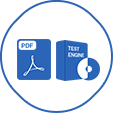Last Update 5 hours ago Total Questions : 320
The LEED Green Associate Exam (LEED GA) content is now fully updated, with all current exam questions added 5 hours ago. Deciding to include LEED-Green-Associate practice exam questions in your study plan goes far beyond basic test preparation.
You'll find that our LEED-Green-Associate exam questions frequently feature detailed scenarios and practical problem-solving exercises that directly mirror industry challenges. Engaging with these LEED-Green-Associate sample sets allows you to effectively manage your time and pace yourself, giving you the ability to finish any LEED Green Associate Exam (LEED GA) practice test comfortably within the allotted time.
Which of the following represents a unit of carbon dioxide equivalent that is reduced, avoided, or sequestered to compensate for emissions occurring elsewhere?
What is the scope of the LEED impact category component Protect Human Health from Direct Exposure to Negative Health Impacts?
In a large site that has a short, intense rainy season and a long, dry season, what component of a collected rainwater irrigation system is most likely to make it cost prohibitive over a conventional system?
The LEED Pilot credit library plays an important role in the continuous evolution of LEED by
What do team members enhance by collaboration during the integrative process?
In addition to the temperature and humidity, what is another factor to consider when implementing thermal comfort strategies?
What plumbing fixture eliminates water use?

